

| Newsletter
Home | ECR
Homepage | ECR
Shop
| ECR
YouTube | ECR
Groups.io | ECR
Facebook |
October
3, 2022
 MORNING BREW Q&A - By Michael K2SHF Thank you to all who checked in to the Morning Brew. The following are answers to some of our recent daily questions. We asked the following questions. As always, only answers with a tally of 2 or more were included below. Thanks to Derby Dan (KD2VNU) for his hard work in logging the answers and tallying the results after each net. 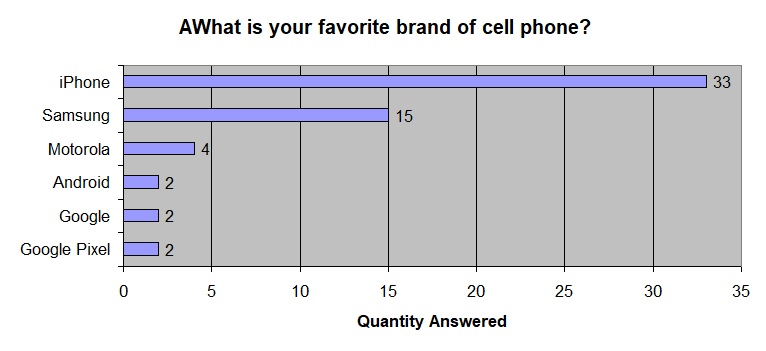 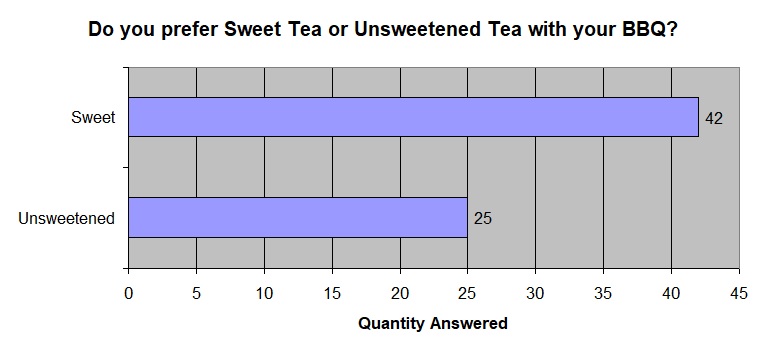 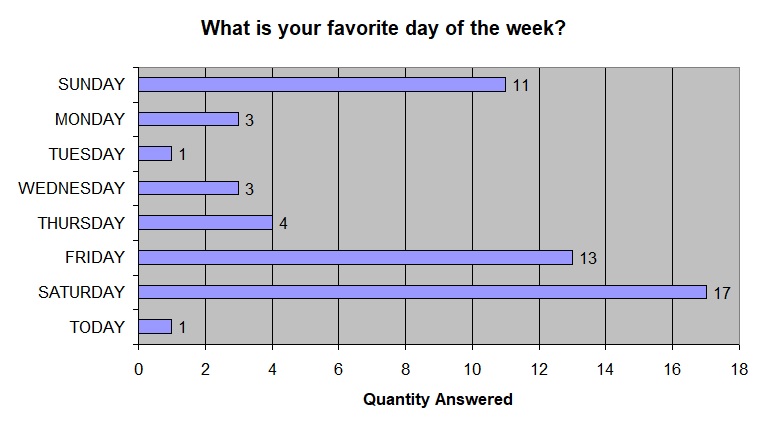 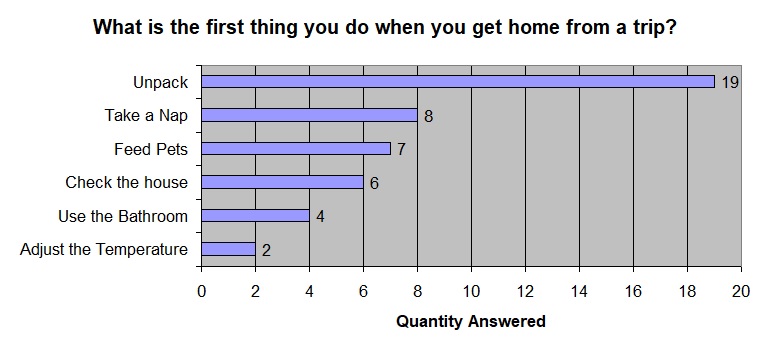  ECR BIRTHDAYS The following hams are celebrating a birthday over the next two weeks. Happy Birthday to you all! KI5CYM, Ray of Seminole TX, has a birthday on October 3rd KO4WNL, Jackson of Seminole FL, has a birthday on October 4th KI7WKZ, Kelly of Oregon City OR, has a birthday on October 7th KF9JF, David of Winter Garden FL, has a birthday on October 8th KO4WIL, Will of Rutledge TN, has a birthday on October 9th KN4TPC, Matthew of Titusville NY, has a birthday on October 10th Would you like your birthday recognized in the Newsletter and on the air during the Tech Net? Just send an email to Michael, K2SHF, with your callsign and birthdate. Your birthday will then be added to our spreadsheet.  THE ANTENNA FARM - By Charles KC6UFM Part 14 – Connectors Hello ECR Family, and welcome to The Antenna Farm. This is your friendly Antenna Farmer Charles, KC6UFM. This time on the Farm, we’re going to have a look at some of the more common RF connectors you will encounter in your time as a ham operator. We’re taking this time because you can have a great antenna, a perfect matching system, and the finest feed line money can buy, but if you can’t hook it all together, you have a pile of junk. We’re also investing some time here because in all antenna systems, no matter the application, the Holy Grail is to have the lowest possible loss. Connectors are often overlooked by hams, even those with many decades of experience, as a source of loss...we are careful to get low-loss feed line, fret over the loss of our matching networks, spend hours making sure our ground losses are minimized, and then put half a dozen lossy connectors in the system. The goal in this article is make you aware of the losses inherent in connectors and encourage you to think about that. There are many different RF connectors available, but only four that are commonly seen in ham radio. Like so many other things, each of these connectors have their advantages and disadvantages. Let’s take a look at these connectors one at a time… The UHF Connector This is probably the most common connector that hams will encounter. Pretty much every mobile and base radio out there has a UHF connector for the RF output. Originally designed by Amphenol in the 1930s, the UHF connector has become so popular that when hams (and professional) operators say “RF Connector,” you can usually assume they mean a UHF type. 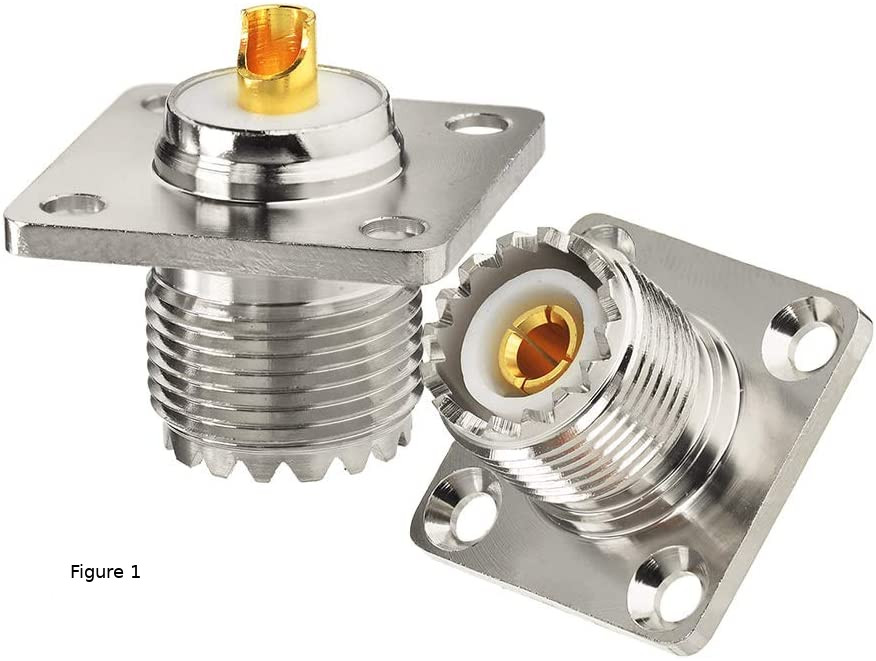  There are two variations that you will commonly see: 1) The SO-239 (see Figure 1) is the female, chassis mount half of the set. This is what you will normally see on the back of your radio. There are several variations for bulkhead mount, pigtail (on a cable) mount, and others, but they are all similar. The female part comes into play because of the small “socket” that the pin from the male half plugs into. 2) The PL-259 (see Figure 2) is the male half of the set. This is what you will normally see on the end of your coax from the antenna. Again, there are some variations. This is the male half because of the small pin in the center that plugs into the socket on the mating female half. The PL-259 is designed for use with RG-8 class coax (about 0.405” in diameter) and Figure 2 also shows the adapter to be used with small coax like RG-58 (about 0.193” in diameter). There are other adapter sizes available as well. UHF connectors have two properties that are important to hams: 1) First, UHF connectors are not waterproof. Any connectors outside must be sealed in some manner to protect them and the cable from the weather. 2) Second, while designed to offer a nominal impedance of 50 ohms, UHF connectors are not constant-impedance devices. That means that there is no guarantee that the connector will actually be 50 ohms. I have, over the years, measured a good number of UHF connectors and found the real world impedance to be someplace between around 40 ohms up to 70 ohms. To be blunt, you get what you pay for...genuine Amphenol UHF connectors tend to be very close to 50 ohms. Cheaper units will be farther off. In addition to the PL-259 and SO-239 versions, there are angle adapters (both 90 and 45 degree are common and there is a much harder to find 30 degree model), through-fittings for bulkheads, couplers, barrels, adapters to other connector types, and many others. The advantage of UHF connectors is that they are fairly inexpensive and fairly easy to work with. Both solder-on and crimp-on versions are available as well as hybrid design that crimps the shield and solders the center conductor. The biggest issue with UHF connectors is their insertion loss at the, interestingly enough, UHF and higher frequencies. Near the end of this article, we’re going to compare the loss of the various connectors. 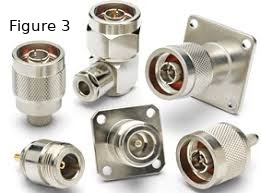 The N-Type Connector Figure 3 shows a collection of several N-Type connectors. There are, roughly, the same types of variations seen in UHF connectors available in the N-Type. While UHF connectors are not waterproof, N-Type are at least watertight. There is a subtle difference between waterproof and watertight...A “Waterproof” connector can be fully submerged and not leak, thus keeping the connection and cable clean and dry. A “Watertight” connector can be exposed to normal weather and dripping/spraying water and keep the connection dry. According to the MILSPEC for N-type connectors, they are to be waterproof. The ones that you can readily buy are usually only watertight. In most cases, what you buy are the devices that the military and NASA have rejected. In other words, they are just fine for almost all amateur uses. Also, N-Type connectors are constant impedance devices. That is to say that they maintain the design impedance through the connector body, usually 50 ohms. Sort of...again, the devices you can readily buy are usually rejects from the QC process. In practice, I have never seen or heard of an N-Type connector that had a changing impedance through the connector body, but it often is not 50 ohms. The consensus is that commercial N-Type connectors will have a constant impedance between 45 ohms and 55 ohms. Not exactly perfect, but somewhat better than a typical UHF connector. There are a few radios that come with N-Type connectors, especially for the higher frequency bands at UHF and above. The sad fact is that almost all radios from the Big Three that are intended for the US market will have UHF connectors. The exact same radio but intended to be sold in the European or Asian market will have N-Type. Also like the UHF connectors, the N-Type family offers a wide array of fittings beyond the simple cable ends and panel mounts. While I’m not prepared to say that 30 and 45 degree angles are not available, I have never seen one in an N-Type. Then again, I never needed one, so I have not really done an extensive search. And just like the UHF connector, N-Type are available as solder-on, crimp-on, and hybrid attachment systems. There are three advantages of N-Type over UHF connectors: 1) As mentioned, the N-Type are watertight, so they shouldn’t need extra protection from the weather. That said, you should still tape with Coax Seal or similar coatings, just as you would for a UHF connector. This is because what we’re dealing with here are devices that the military and NASA don’t want because they have some defect or another. 2) The N-Type are constant impedance devices. Sort of. The vast majority of UHF connectors will be in the same range as the N-Type as far as actual impedance is concerned, and while there is no guarantee of the impedance through the UHF connector being constant, for most straight connectors it will be very close. Angles are the worst about variable impedance, and this limit applies equally to UHF and N-Type. What I’m trying to say here is that, in practice, there is little difference between a UHF and N-Type connector as far as impedance is concerned. 3) Next, the N-Type has lower loss than the UHF. At 6m and below, you can’t measure the difference. As you move up to 2m and beyond, this may become important. Again, we’re going to look at the loss of the connectors below. 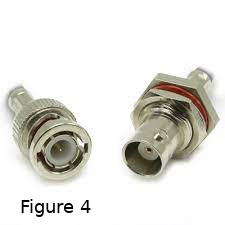 The BNC Connector There is some disagreement as to what BNC stands for, but the main contestants are Bayonet Neil-Concelman or British Naval Connector. I’m not sure it matters because everyone just calls them BNC Connectors. See Figure 4 for a couple of common BNC types. Essentially, the BNC connector shares some features of both the UHF connector (relatively cheap and easy to work with) and the N-Type connector (constant impedance). It is worth noting that BNC connectors are available in 50, 75, and 93 ohms impedance, though the 93 ohm devices can be hard to find and expensive. Most BNC connectors are watertight, and there are fully waterproof versions available. For many years, the BNC connector was the de facto standard for the antenna port on HTs. If you have an older HT (or know someone who does), it may have a BNC connector. Also like the UHF and N-Type connector, there are a wide range of fittings available to do particular jobs. The biggest advantage of the BNC is its size and price. We’ll look at loss in more detail below, but the BNC performs well. 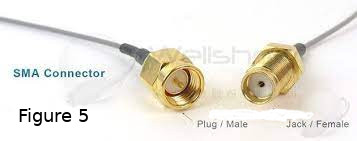 The SMA Connector In recent years, the SMA Connector (see Figure 5) has become the most common connector found on HTs and SDR devices. The reason this is the case is actually very simple...SMA connectors are dirt cheap. Every penny the manufacturers can save on a part for an HT is a penny they can put in their pocket. The only three things SMA connectors have going for them are: 1) They are so cheap. This saves money for the manufacturer. 2) They have a constant impedance (available in both 50 and 75 ohm versions). 3) They are small. Makes the SMA especially well suited for extremely high frequency uses. There are a number of variants similar to the other common connectors for the SMA line, but the most important one for manufacturers is the PCB mount. This version can be machine mounted and soldered to the printed circuit board very easily. The biggest disadvantage of an SMA connector is that it is not designed to survive a large number of connect/disconnect cycles. The SMA was initially designed to be used INSIDE equipment to connect between stages, and so would be connected once at the factory and maybe a few times during QC checks and later field service. It was never intended to be an everyday connector that would be changed often. On top of the actual parts failing due to overuse, SMA connectors tend to be a bit fragile—especially the PCB mount types—and can break easily. Above you have learned about the common RF connectors you will run into in your daily life as a ham operator. We have skipped over some details like actual loss figures, maximum voltage rating, and life span, even though these are important factors in connector selection. The main reason for holding this information til now is that it tends to be more useful in a table format than as text. In the table that follows, there are a couple of things you need to keep in mind… First, the loss figures are spread across frequency ranges by ham band. In other words, where the chart says “10m”, that is the loss at the highest frequency of the US 10m ham band (29.7 MHz) and you can safely assume that as you go lower in frequency, the loss also goes lower. Simply to keep the chart small and simple, I have tabulated loss only for the 10m through 23cm (1.3 GHz) bands. If a connector is not rated for a particular band, it will show NA for that position. This does NOT mean that the connector is not used at those frequencies, only that it is outside of the design and testing envelope. The loss shown is in dB of loss for a mated pair of connectors. That is to say, if you have a PL-259 on your cable plugged into the SO-239 on the back of your radio, that is a mated pair. Second, For maximum voltage rating, in almost all cases, the cable you use will have a lower voltage rating than the connector. Also, the actual dielectric strength of the insulators in the connector typically has a value of about three times the rated voltage. Keep this in mind. Also remember that if you have full legal limit power (1500 watts), the MINIMUM voltage on your antenna system (assuming 50 ohms impedance) will be about 275 volts. If there is any reactance or mismatch (SWR other than exactly 1:1), the voltage can be MUCH higher, easily as much as 500 volts and sometimes even more. As if you needed another reason not to touch the end of your dipole. Connector Type UHF N-Type BNC SMA Max Voltage 500 500 500 500 Life Cycles 1000 750 800 50 Loss at 10m 0.05 0.01 0.025 0.015 Loss at 6m 0.1 0.019 0.02 0.029 Loss at 2m 0.5 0.095 0.1 0.11 Loss at 1.25m 0.65 0.13 0.19 0.22 Loss at 70cm 1.01 0.38 0.41 0.58 Loss at 33cm NA 1.25 NA 1.89 Loss at 23cm NA 2.51 NA NA As you can see, at 10m and below, the slight change in loss is simply too small to make it worth changing even a single connector pair. For a typical station with two connector pairs between the radio and the antenna, 6m, 2m, and 1.25m are very much judgment calls...is it worth it to YOU to make a change that will lower your loss by 0.75 dB or so? At 70cm, the change becomes more clear...you will see a difference if you drop the UHF connectors in favor of N-Type...or BNC. Maybe… Cost is a big factor. Genuine Amphenol silver plated PL-259 connectors are about $6 each. Genuine Amphenol silver plated N-Type connectors are around $21 each. You can roughly double these prices for a mated pair. In summary, a good quality, properly installed UHF connector is a good overall value at 1.25m and below. At 70cm, N-Type are probably worth the time and money. And since the majority of ham stations use a dual-band antenna with a dual-band radio, there will only be one run of feed line, so you might as well go with the N-Type to handle the “worst case” scenario of 70cm operations. That said, a BNC would be a cheaper, viable option. And one final warning here...the use of an adapter (let’s say a UHF (PL-259) to N-Type so you can run N-Type coax to the antenna is counted as TWO mated pairs...one for the adapter to the radio and another from the adapter to the coax. Odds are, you just ate up that saved loss. Proper Installation Yes, we need to look at this for a moment. Remember back in Article 5 when we talked about tools and I made a big deal about getting a coax stripper? Well, I’m going to do it again. Never EVER try to strip coax with a knife! You are 100% guaranteed to damage the center conductor. All it takes is a nick in the wire that is 0.1mm (yes, that’s 10 micrometers or 0.0004”) deep to alter the impedance of the cable. At that point, the big selling points of a particular connector being constant impedance and low loss just went down the toilet. 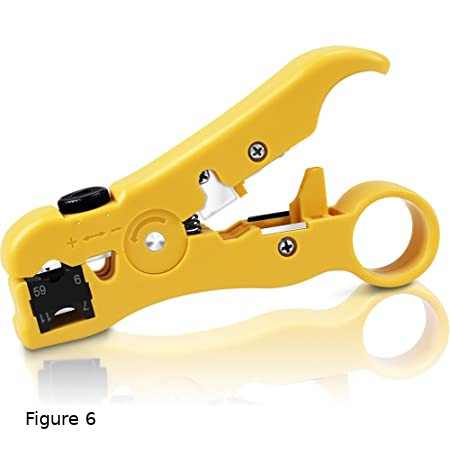 Instead, get yourself a good coax stripper. See Figure 6. They aren’t expensive, in the $20 range. Most of the better ones have three fully adjustable blades that will strip the coax in one easy operation after it has been fully adjusted. Count on making at least half a dozen “practice” strips to get it tweaked in. Besides, you’re less likely to cut your fingers. 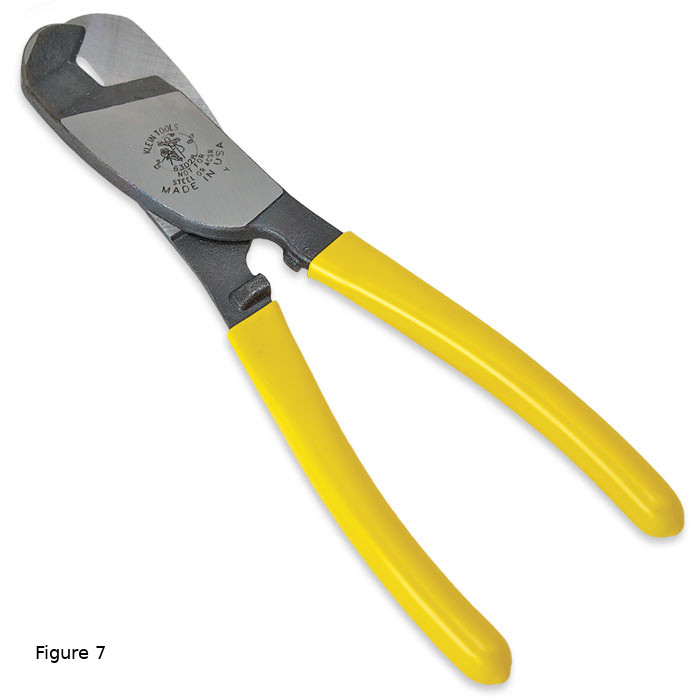 While you’re buying the coax strippers, also get a good cable cutter. See Figure 7. These are nice because they don’t crush the coax as you cut it and they have good leverage to cut through heavy coax and cable with ease. You can get a good pair of name brand cutters for around $30. Next, if you plan to solder on your connectors, get at least a 250 watt, high quality soldering gun. Weller makes the best ones. You can expect to pay close to $50 for this. If you plan to use crimp-on connectors, get a quality crimper designed to work with the coax and connectors you are using. These are NOT cheap, so don’t try to save money here. You’ll get some change back from a $100 bill. A little, anyway. If you’re like me and want to use the hybrid connectors, you’ll need the crimping tool and a soldering gun. Hey, it’s only money and we’re talking about ham radio here! Just a brief aside...there are people who would never use a crimp-on connector, and they have a long list of reasons why not. There is an equally loud group who would never use a solder-on connector, and they have a long list of reasons why not. Actual tests in the lab and in the field using a million dollars worth of calibrated test equipment has found that there is no detectable difference between solder and crimp types IF they are properly installed. And that’s the rub...it’s easy to get careless and botch the installation no matter what type of connector you use. Personally, I like the hybrid connectors where I strip the coax, crimp the shield, and solder the center conductor. That’s just me. Do what you like, but do it RIGHT. Lastly, get some heat shrink tubing and a heat gun. An assortment of tubing will probably be OK, but get a good heat gun. Don’t use the XYL’s hair dryer and don’t use matches or a lighter. Neither of these will end well. And be sure to read the directions for all of your tools and the data sheet for the connectors. Reading the technical specs for the coax you’re using will also yield some important information like the depth settings for your coax stripper. Everything you need to know will be there. When done, test your work. If you have an analyzer or VNA, you can use that to measure the line impedance. If not, why?? I mean, if not, you can use a multi-meter set to it’s highest resistance range (usually 2 meg-ohms) and make sure there is no continuity between the center and shield. In fact, even if you buy pre-made coax, you should always check it before you use it. Connector Wars There are people out there who are absolutely rabid in favor of one connector and/or against one connector. Just like with so many other things, about 99% of them can’t defend their position beyond parroting back misinformation they have been fed. Someday I’ll tell you about the one man (a now SK ham) who effectively destroyed packet radio because he: (1) Was upset that no one was using his packet software, and (2) Was able to use big words he didn’t understand and bully people into believing him. The real deal here is that there is no one “best” connector. Each type has its good points and its bad points. A connector that will be a top-performer in one situation, might only barely work in another. And this is all to our benefit as hams. Once we understand what a connector needs to do for us and we understand the demands that will be put on the connector, we are able to pick the best option for that particular application. Take an SMA connector...inside a cabinet connecting various RF stages together, it’s hard to beat an SMA. If, however, you are looking for a connector to terminate the coax into your new beam, 50 feet up in the air with the full impact of the elements hitting it, an SMA is probably about the worst choice in that case. Don’t let the Connector Wars influence you...do your own due diligence with an open, educated mind and pick a connector that will do the job you need it to do. In our next visit to the Farm, we’re going to have a look at the basics of the Yagi-Uda Beam Antenna. This is of interest to us not only because it is an effective antenna in and of itself, but also because, as you’ll learn, in the VHF and higher bands, it really isn’t the best choice. Take Care & 73 de KC6UFM Charles AN INTERVIEW WITH JEFF KD2WFW - By Lucca KD2YHZ Here is the interview I did with Jeff KD2WFW. Thank you, Jeff, for participating. Q: How long have you been licensed as a Ham? A: I received my tech license April of 2021. Q. Do you have your General or Amateur Extra? A: I received my General May of 2021 then my Extra January of 2022. Q: What got you into getting licensed as a Ham? A: I got into Ham radio for a new hobby that isn’t weather dependent and now it’s the only hobby I have interest in. Q: What do you enjoy most about Ham Radio? A: My favorite part of Ham radio is DX. Q: What's your favorite Radio Band? A: My favorite band is 20 meters. Q: Have you made any contacts with people in different countries? If so how many? A: I have talked to 124 countries with 106 confirmed. Q: What's your favorite Radio? A: I don’t think I have a favorite brand of radio but I have Icom radios. My favorite radio is my Icom 7300. Thanks again, Jeff. More interviews coming soon! NEW ALEXA SKILL FOR LISTENING TO THE ECR - By Terry N3ETH Hi my name is Terry Neth. My callsign is N3ETH. I have built a skill for Alexa. Do a search for "East Coast Reflector" and download to your account. Then just say to your Alexa device, "Play East Coast Reflector". You will hear a ad from Broadcastify, and then it will start to play the audio. There is a delay just like any other source from Broadcastify. Thank You Terry Neth N3ETH 73's CLUB GRANT APPLICATION PERIOD OPEN UNTIL NOVEMBER 4 Taken from The ARRL Letter dated September 29, 2022 The ARRL Foundation Club Grant Program opened a second grant proposal period which began September 7, 2022, and runs until November 4, 2022, at 7 PM Eastern Time. Radio clubs can apply now, and information about the program can be found on the ARRL website at www.arrl.org/club-grant-program. Following the first proposal period that ran earlier this year, 128 clubs applied for grants with a variety of outstanding projects. Emphasis is placed on projects that have a component of community involvement, training, new ham development, and club revitalization. Twenty-four clubs were chosen and nearly $270,000 was awarded. Clubs that applied in the first round and did not receive a grant are urged to reapply. The ARRL Foundation will award an additional $230,000 in grants at the end of the second application round. An informational webinar was held on September 7, and a recording of that event can be seen on ARRL's YouTube channel at https://youtu.be/ZNvc_eeIIwU. JUST AHEAD IN RADIOSPORT Taken from The ARRL Letter dated September 29, 2022 October 3 RSGB 80-Meter Autumn Series (CW) October 4 ARS Spartan Sprint (CW) October 5 432 MHz Fall Sprint (CW, phone, digital) October 5 5 UKEICC 80-Meter Contest (phone) October 6 SARL 80-Meter QSO Party (phone) October 6 NRAU 10-Meter Activity Contest (CW, phone, digital) October 6 SKCC Sprint Europe (CW) Visit the ARRL Contest Calendar for more events and information. HOW CAN YOU HELP OUT WITH THE NEWSLETTER? If you have any interest in giving us a hand, please send an email to K2SHF. Send us links, articles, pictures, anything really. And if you have knowledge in a subject that you think our readers would find interesting, perhaps you could write some articles. "This is a team effort".  YACHT NEWS for October 1, 2022 Young Amateurs Communications Ham Team, K8KDZ, Sailing Through Radio Waves Connecting Young Hams, Creating Friendships, Expanding the Voice of Youth in Ham Radio Inspiring Youth with Enjoyment & Technology of Ham Radio A youth oriented echolink event each evening 7pm CDST Mon to Sun Making a Difference with Youth -------------------- NET REVIEW... A well attended Youth Net with 21 stations along for the cruise. Thanks to these young hams: 2W0KYH, NC8R, K9ZN, N6RWC, KN6ULC, K0NNK, KC3OTG, K8JDT, KE0ZNV, KC3RAP, N8JJM, KE8LQR, KF0JFQ. CHAT SESSIONS... Monday: These youth hams checked in, K0NNK, KC3RAP, NC8R, KE8LQR, KE0ZNV, N8JJM, VA3BHT along with the following, KF4RHZ, ZL3DUG, K5NO. KC3CDU (no audio) Tuesday: 4 youth stations popped on board: KE0ZNV, NC8R, KC3RAP, YS1YXI (El Salvador) Nice to hear from Mily after an extended absence due to school committements. Total of 8 checked in. Join us this evening for our Hurricane Ian chat session. Looking Ahead: The session on Thurs. October 13 will be covered by Cameron KD9VGV. Then on Wed. Oct.19, I will need someone to run that session as I expect to be part of a local VE exam session. If there is a change in time and date, I will let you know. Bradley KC1PEH has agreed to take the October 19 chat session. He has already run two Sunday evening nets for Collin and has done very well. Thanks to Cameron and Bradley. MAJOR RADIO EVENTS COMING UP... JOTA/JOTI (Jamboree On the AIR/Internet) for Scouts, October 14-16 School Club Roundup October 17-21 CQ WW SSB Contest October 29-30 NATIONAL HURRICANE CENTER... This link will give you a complete background and current use of WX4HNC. You will find it very informative as Hurricane Ian invades Florida https://w4ehw.fiu.edu/?fbclid=IwAR28uKo1AJhD8CYGww2TcwQCfy3-j18hIjJ38YReHhOLQS7FnUnjcLGiHvs Monitor 14.325.00 for current hurricane conditions along with health and welfare traffic. They also use 7.268 in evenings. Here is the official ARRL post on the hurricane [link] FLORIDA STATE WIDE REPEATER SYSTEM... SARNET is the Florida Repeater System which is in operation for Hurricane Ian. You can listen in and follow activity state wide. Be aware though, that there will be periods of silence when no transmissions are heard. [link] YOTA CAMP 2023... will be held in Ottawa, Ontario Canada next year. The date is July 16 to 21. Information is here for interested YACHT members to check out https://youthontheair.org/ottawa2023/ Young hams from N.A., C.A, and S.A. ages 15 to 24 are eligible. We have a large group of YACHT youth who would be excellent candidates for acceptance. Two are already interested. FATHER/SON TEACH TECHNICIAN CLASS... This came in from Lee Kahler, dad to youth member Vincent KC3RXV "H.A.M. Radio - Technician Class Taught by Vincent (Age 10) and his Dad Lee Kahler Sundays at 7-7:30p ET via Zoom This is the first of several licenses available from the FCC and enables someone to explore the world of Amateur Radio. Children as young as 5 years old have attained this basic licensing. Once achieved, your license is valid for 10 years. This STEM activity is wonderful for the whole family. Our weekly schedule of lessons will take several months but will get you and the family ready to take the certification test. Below is the expected schedule. If you’re unable to make it to a lesson one week, no worries. Progress is always better than perfect attendance. 10/16 11/20 12/25 - off 1/29 3/5 10/23 11/27 - off 1/1 - off 2/5 10/30 12/4 1/8 2/12 11/6 12/11 1/15 2/19 11/13 12/18 1/22 2/26 Registration is Free!!! If interested, please send an email to epickahler@gmail.com with the names of those interested in participating and we’ll add you to the Zoom invite." YL SSB SYSTEM NET CHANGE FOR YOUTH... Starting October 1 this net will move to Saturdays at 4pm CDST, 5pm EDST, 3pm MDST, 2pm PDST. Frequency is 14.332.00. Daniel NC8R will have his first N.C. duty at that time as he has been accepted by the system for net operation. Lyle KE0ZNV and Nick KO4PPD are also registered and trained youth. Any others interested can contact Larry AB3TY at his QRZ email. This is an active HF group in operation since 1963 with check ins and members nationwide. They are very informal, friendly, and helpful. Their various nets are held daily on 14.332.00 Those youth with General and Extra class licenses are invited to check out their website and become familiar with the group. Additional youth net controls would be welcome. Go to https://ylsystem.org/ YOTA CROATIA SUMMER CAMP AWARD AND NEW MEMBER... This young fellow received the award recently. Congratulations to Adrian EA2ESK of Spain, age 14. I have written to him and perhaps some day he will connect up to us on echolink. He is in the middle. Update: he is now a youth member #435. Welcome aboard Adrian. http://www.qrz.com/db/ea2esk 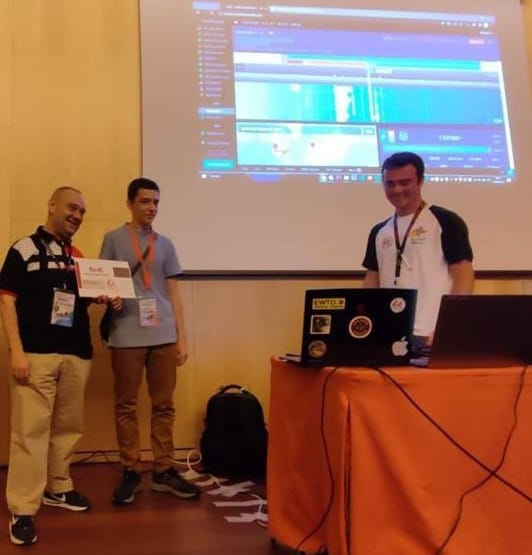 LARGEST R/C PLANE... This A380 is a huge model and is expertly flown. Have never seen one larger https://www.facebook.com/watch/?v=683353146209710 HERE COMES AN EXTRA... Congratulations to Liam Gazely KI5JXQ. He just passed his Extra class exam and now has full use of the amateur HF bands. HAM RADIO HELPS IN AN EMERGENCY... An 81 year old sailor receives assistance from hams on the west coast [link] -- 73, Ed Engleman KG8CX http://yachthams.webstarts.com/index.html http://w8pif.webstarts.com/index.html http://www.qrz.com/db/k8kdz |
| FACILITATORS Dick WB2JPQ Henry WB4IVB Emil WA2UPK Bob KB3SNM Tony W2KJV Kevin VE3BZ Paul W4END David KB4FXC Kevin KE7K Joe KO4FRR Mike K2CMT Michael K2SHF Keynon KB5GLC Dan KD2VNU Caleb KO4UYJ Scott W2BLT |
ECR ACCESS IRLP 9050 AllStar 27339, 45192, 45225 Echolink WB2JPQ-R(57780), WB2JPQ-L(375103) DMR Brandmeister 3129973 DMR TGIF 9050 System Fusion 44444, 92805 DStar XRF(XLX)256E HamShack Hotline 94049 P25 31582, 9050 M17 M17-ECR Module A Hams Over IP 15001 NETS Tech Net Tuesdays 8PM ET Morning Brew Mon-Fri 7AM ET YACHT Youth Net Wednesdays 8PM ET |
WEBPAGE http://eastcoastreflector.com ZOOM ROOM Open 24/7. All are welcome! ID: 83929643320 Password: 193414 http://bit.ly/ecrdaily MERCH SHOP http://bit.ly/ecrshop TECH NET LOG http://bit.ly/ecrtechnet YOUTUBE CHANNEL http://bit.ly/ecrYouTube |